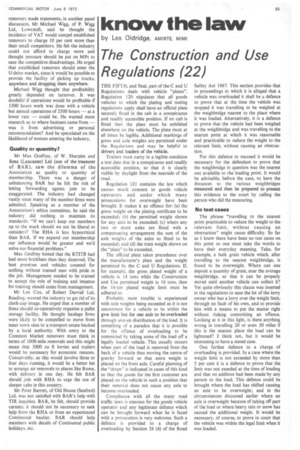know the law
Page 55

If you've noticed an error in this article please click here to report it so we can fix it.
by Les Oldridge, AMIRTE, MIMI
The Construction and Use Regulations (22)
THE FIFTH, and final, part of the C and U Regulations deals with vehicle "plates". Regulation 120 stipulates that all goods vehicles to which the plating and testing regulations apply shall have an official plate securely fitted in the cab in a conspicuous and readily accessible position. If no cab is fitted then the plate must be exhibited elsewhere on the vehicle. The plate must at all times be legible. Additional markings of gross and axle weights are permitted under the Regulations and may be helpful to drivers and loaders of the vehicle.
Trailers must carry in a legible condition a test date disc in a conspicuous and readily accessible position, so that it is clearly visible by daylight from the nearside of the ' road.
Regulation 121 contains the law which causes much concern to goods vehicle operators and under which many prosecutions for overweight have been brought. It makes it an offence for: (a) the gross weight on the plating certificate to be exceeded; (b) the permitted weight shown for any axle to be exceeded; (c) where any two or more axles are fitted with a compensating arrangement the sum of the axle weights of the axles so fitted to be exceeded; and (d) the train weight shown on the "plate" to be exceeded.
The official plate takes precedence over the manufacturer's plate and the weight permitted by the C and U Regulations. If, for example, the gross plated weight of a vehicle is 14 tons while the Construction and Use permitted weight is 16 tons, then the 14-ton plated weight limit must be adhered to.
Probably most trouble is experienced with axle weights being exceeded as it is not uncommon for a vehicle to be within the gvw limit but for one axle to be overloaded through uneven distribution of the load. It is something of a paradox that it is possible for the offence of overloading to be committed by taking some of the load off a legally loaded vehicle. This usually occurs when part of the load is removed from the back of a vehicle thus moving the centre of gravity forward so that extra weight is placed on the front axle. Careful planning of the "drops" is indicated in cases of this kind so that the goods for the first customer are placed on the vehicle in such a position that their removal does not cause any axle to become overloaded.
Compliance with all the many road traffic laws is onerous for the goods vehicle operator and any legitimate defence which can be brought forward when he is faced with a prosecution is very welcome. Such a defence is provided to a charge of overloading by Section 26 (4) of the Road Safety Act 1967. This section provides that in proceedings in which it is alleged that a vehicle was overloaded it shall be a defence to prove that at the time the vehicle was stopped it was travelling to be weighed at the weighbridge nearest to the place where it was loaded. Alternatively, it is a defence to prove that the vehicle had been weighed at the weighbridge and was travelling to the nearest point at which it was reasonable and practicable to reduce the weight to the relevant limit, without causing an obstruction.
For this defence to succeed it would be necessary for the defendant to prove that the weighbridge in question was the nearest one available to the loading point. It would be advisable, before the case, to have the distances to the various weighbridges measured and then be prepared to present this evidence to the court by calling the person who did the measuring.
No test cases The phrase "travelling to the nearest point practicable to reduce the weight to the relevant limit, without causing an obstruction" might cause difficulty. So far as I know there have been no test cases on this point so one must take the words to have their everyday meaning. Take, for example, a bulk grain vehicle which, after travelling to the nearest weighbridge, is found to be overweight. Where can one deposit a quantity of grain, near the average weighbridge, so that it can be properly stored until another vehicle can collect it? Yet quite obviously this clause was inserted in the regulations to ease the lot of the lorry owner who has a lorry over the weight limit, through no fault of his own, and to provide him with a means to put the matter right without risking committing an offence. Looking at it in this light, is there anything wrong in travelling 20 or even 50 miles if this is the nearest place the load can be lightened? I think not, but it would be interesting to have a stated case.
One further defence to a charge of overloading is provided. In a case where the weight limit is not exceeded by more than 5 per cent it is a defence to prove that the limit was not exeeded at the time of loading and that no addition had been made by any person to the load. This defence could be brought where the load has shifted causing an axle to be overweight; and in the circumstances discussed earlier where an axle is overweight because of taking off part of the load or where heavy rain or snow has caused the additional weight. It would be necessary, of course, to prove in court that the vehicle was within the legal limit when it was loaded.




































































































